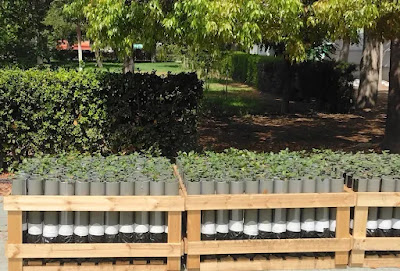Cyprus Mail 19 November 2024 - by Jonathan Shkurko
Over 3,000 drought-resistant and aromatic plants have been planted in areas of Cyprus farmland at risk of desertification, the environment commissioner said on Tuesday.
By 2026, the EU co-funded LIFE-AgrOassis project aims to establish approximately 18,000 plants forming hedgerows spanning 30 kilometres around cultivated areas.
Speaking at the start of the project’s second year, Environment Commissioner Antonia Theodosiou highlighted the urgency of addressing desertification, which she described as a growing issue in Cyprus due to the impacts of climate change.
“The climate crisis demands immediate action and practical measures to adapt to its consequences,” she said.
The project, coordinated by the Agricultural Research Institute (ARI) and supported by multiple governmental and research organisations, aims to protect soil and vegetation.
Theodosiou explained that the hedgerows act as natural barriers, helping to retain soil moisture, prevent erosion and create better conditions for plant growth.
“The creation of hedgerows is a sustainable use of land, improving soil conditions while reducing irrigation needs,” she said.
Project coordinator Dr Panayiotis Dalias said during the first planting season, 7.6 kilometres of hedgerows were established in areas including Tersefanou, Denia, Akaki, and Peristerona.
“Over 200 hectares of land have been included in the project so far, and this was achieved with the participation of 380 volunteers,” he said.
The next planting phase, running until January 2025, will see double the number of trees and shrubs planted, focusing on areas in Larnaca and Nicosia.
Native species, including olives, carobs, pistachios and wild pears, have been chosen for their drought resilience and adaptability to local conditions.
“Selecting indigenous species ensures the long-term sustainability of the hedgerows,” Theodosiou said.
Dalias explained that farmers submit applications to include their land in the scheme, with the most vulnerable plots prioritised.
“We focus on areas most at risk of desertification,” he said, adding that the project also considers state-owned land leased to farmers.
The project employs innovative techniques to improve plant survival rates. The scientific coordinator from the KES Research Centre Dimitris Sarris introduced a new method that promotes deep root growth, increasing plant resilience to drought.
“Using root-deepening tubes, we achieved significant results during trials, with nearly 100 per cent survival rates for olives under extreme summer conditions,” he said.
Beyond addressing desertification, the project contributes to reducing greenhouse gas levels by acting as a carbon sink.
“To reach climate neutrality, it’s not enough to reduce emissions. We must also enhance the natural absorption of greenhouse gases,” Theodosiou said.
In addition to environmental benefits, the hedgerows support biodiversity by serving as ecological corridors and habitats for wildlife, pollinators, and beneficial insects.
